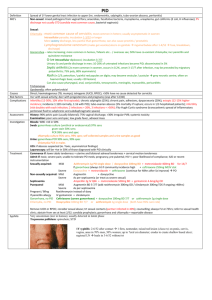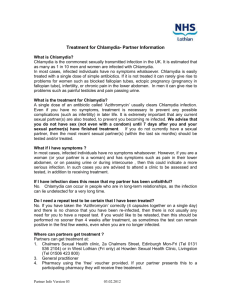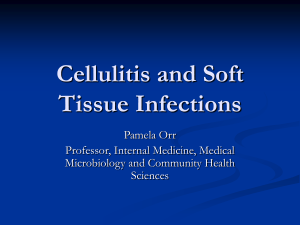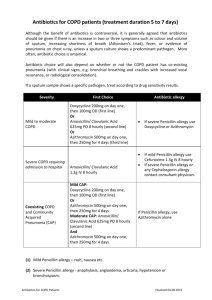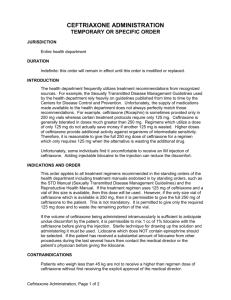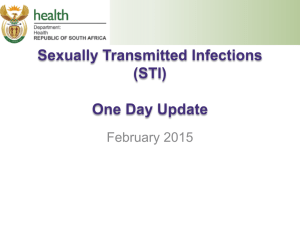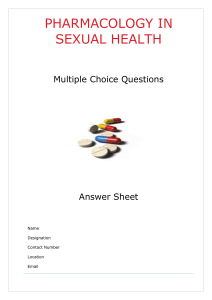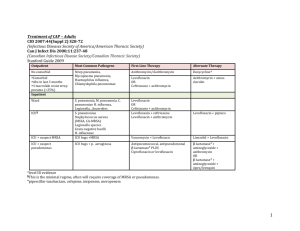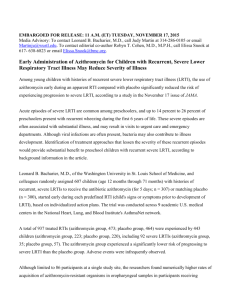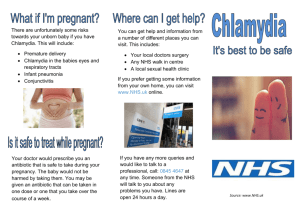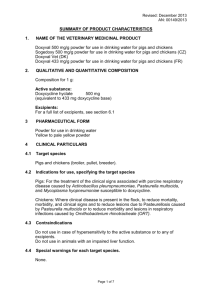Public Health England GRASP Steering Committee and BASHH
advertisement
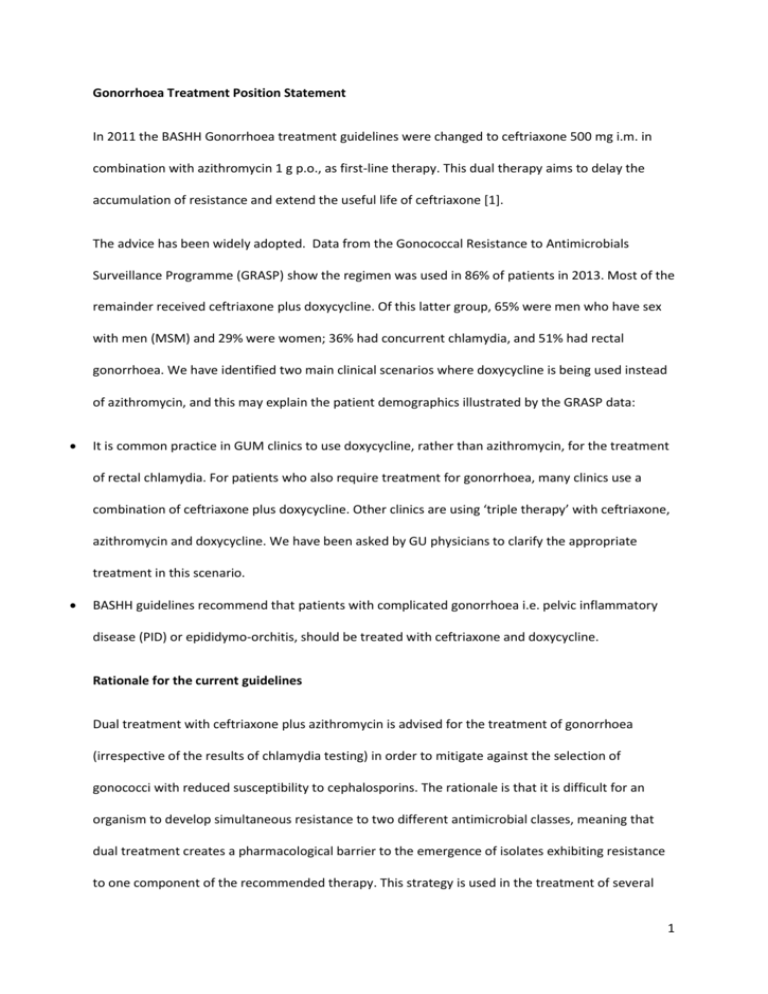
Gonorrhoea Treatment Position Statement In 2011 the BASHH Gonorrhoea treatment guidelines were changed to ceftriaxone 500 mg i.m. in combination with azithromycin 1 g p.o., as first-line therapy. This dual therapy aims to delay the accumulation of resistance and extend the useful life of ceftriaxone [1]. The advice has been widely adopted. Data from the Gonococcal Resistance to Antimicrobials Surveillance Programme (GRASP) show the regimen was used in 86% of patients in 2013. Most of the remainder received ceftriaxone plus doxycycline. Of this latter group, 65% were men who have sex with men (MSM) and 29% were women; 36% had concurrent chlamydia, and 51% had rectal gonorrhoea. We have identified two main clinical scenarios where doxycycline is being used instead of azithromycin, and this may explain the patient demographics illustrated by the GRASP data: It is common practice in GUM clinics to use doxycycline, rather than azithromycin, for the treatment of rectal chlamydia. For patients who also require treatment for gonorrhoea, many clinics use a combination of ceftriaxone plus doxycycline. Other clinics are using ‘triple therapy’ with ceftriaxone, azithromycin and doxycycline. We have been asked by GU physicians to clarify the appropriate treatment in this scenario. BASHH guidelines recommend that patients with complicated gonorrhoea i.e. pelvic inflammatory disease (PID) or epididymo-orchitis, should be treated with ceftriaxone and doxycycline. Rationale for the current guidelines Dual treatment with ceftriaxone plus azithromycin is advised for the treatment of gonorrhoea (irrespective of the results of chlamydia testing) in order to mitigate against the selection of gonococci with reduced susceptibility to cephalosporins. The rationale is that it is difficult for an organism to develop simultaneous resistance to two different antimicrobial classes, meaning that dual treatment creates a pharmacological barrier to the emergence of isolates exhibiting resistance to one component of the recommended therapy. This strategy is used in the treatment of several 1 other infections, for example HIV and TB. GRASP data show that current resistance rates to azithromycin are low (1.6%), whereas tetracycline/doxycycline resistance rates remain high (72.9%), therefore ceftriaxone plus doxycycline does not reliably give the double coverage sought, allowing easier selection of ceftriaxone resistance. The current BASHH guidelines are going to be revised to clarify this rationale. ‘Synergy’ is presently indicated as one of the reasons for the recommendation of dual therapy and it is also important to clarify that there is no good evidence for any antimicrobial synergy between ceftriaxone and either azithromycin or doxycycline [2], and this is not the reason for recommending dual therapy. Future Guidance It is reassuring that the majority of patients are receiving appropriate first line ceftriaxone plus azithromycin therapy for gonorrhoea. However, in regard to the issues identified above, we note and suggest the following: Co-infection with rectal chlamydia: There are no randomised controlled trials to provide a strong evidence base for the optimum antimicrobial treatment of rectal chlamydial infection. Guidance cannot be extrapolated from studies to assess treatment for genital chlamydia. A few studies and a meta-analysis have found 1 g of azithromycin p.o. to be inferior to 7 days of doxycycline 100 mg twice daily for the treatment of rectal chlamydia [3-5]. It is likely that further clinical studies are needed to resolve the issue. Until this evidence is available, we would recommend specific treatment of each infection i.e. ceftriaxone combined with azithromycin for the gonorrhoea, with the addition of doxycycline for the concurrent rectal chlamydia. This advice is to be included in the updated BASHH Chlamydia treatment guidelines. PID: Data supporting azithromycin use in PID are limited, and the quantity of evidence is larger for doxycycline. However the infection is rare: of 15,758 reported cases of PID in 2013 only 323 (2%) involved gonococci. This may be an underestimate but, on balance, we believe that it is reasonable 2 to continue the use of ceftriaxone and doxycycline in this patient group: given the small subset of patients with N. gonorrhoeae, it is unlikely to impact on measures to delay the development of widespread ceftriaxone resistance. Test-of-cure (TOC): The importance of TOC for all patients, but particularly for those not treated with dual gonococcal therapy, must be emphasised. Dr Helen Fifer and Dr Gwenda Hughes on behalf of the GRASP Steering Group Dr Keith Radcliffe on behalf of the BASHH Clinical Effectiveness Group Acknowledgments We would like to thank the members of the GRASP Steering Group and BASHH Clinical Effectiveness Group for their valuable input into these discussions. References 1. Bignell C, FitzGerald M. Guideline Development Group; British Association for Sexual Health and HIV UK. UK national guideline for the management of gonorrhoea in adults, 2011. Int J STD AIDS. 2011 Oct; 22(10):5417. 2. Wind CM, de Vries HJ, van Dam AP. Determination of in vitro synergy for dual antimicrobial therapy against resistant Neisseria gonorrhoeae using Etest and agar dilution. Int J Antimicrob Agents. 2015 Mar; 45(3): 305-8. 3. Hathorn E, Opie C, Goold P. What is the appropriate treatment for the management of rectal Chlamydia trachomatis in men and women? Sex Transm Infect. 2012 Aug; 88(5):352-4. 4. Khosropour CM, Dombrowski JC, Barbee LA et al. Comparing azithromycin and doxycycline for the treatment of rectal chlamydial infection: a retrospective cohort study. Sex Transm Dis. 2014 Feb; 41(2):79-85. 3 5. Kong FY, Tabrizi SN, Fairley CK et al. The efficacy of azithromycin and doxycycline for the treatment of rectal chlamydia infection: a systematic review and meta-analysis. J Antimicrob Chemother. 2015 May; 70(5):1290-7. 4
